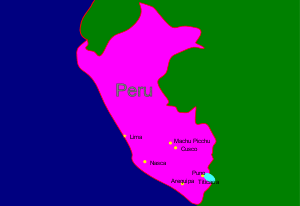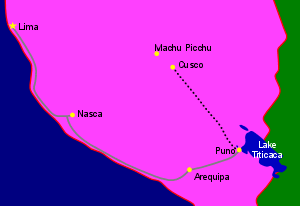Pre-Incas
Like all civilisations, the Incas developed the best from earlier peoples, the so-called Pre-Incas
Chavin 1000BC-200BC:
Unified society; Grand stone buildings; textiles; ceramics; gold-working techniques.
Moche 200BC-700AD:
Belligerent conquerors; Vast adobe (unfired clay & straw) buildings; Advanced metallurgy; Ceramics; Art.
Nasca 200BC-700BC:
Desert dwellers; Extreme water expertise; Advanced underground waterways, still in use;
World famous Nasca lines; Fine pottery with colourful decoration.
Tiahuanaco 700BC-1000AD:
Skilled farmers; Engineered fields; Buildings & Pyramids of dressed stone; Perfect mortarless joints;
Fine wood carvings; gold; textiles
Huari 700BC-1000AD:
Similar to Tiahuanaco but probably enemies; Skilled in canals, irrigation and terraced farming.
Chimu 1000-1450:
Adobe buildings & tombs; Master craftsman; Finest metalwork in gold and silver.
The Incas
"Inca", or "Sapu Inca", is the monarch. The "Incas" were his people. Inca Pachacutec, a folk hero, deserves special mention.
Pachacutec 1438-1462:
The ninth Inca who, after defending against the Canchas, is said to have rebuilt Cusco in stone
fashioned on Tiahuanaco; built Sacsahuaman; and massively expanded the Inca empire.
The Empire:
The Incas were a dual class monarch-led society with advanced hierarchical administration system for the whole empire,
including a system of taxation. They didn't have writing, but had a system of record keeping involving knotted strings (quipus).
At it's peak the Inca empire stretched 3400 miles, connected by a comprehensive and efficient road system, totalling maybe 20,000 miles.
The Incas developed the architectural and engineering skills of their ancestors and, integrating their structures into the landscape,
achieved a level of total perfection. They built in many styles and are most famous for the perfect motarless joints they achieved on
the huge stones of their finest buildings. They took the production of textiles, ceramic and metalwork to similar heights of perfection,
even developing alloys of Gold to deliver a gold effect using less of the metal itself.
The Fall:
In 1532, when the Incas were weakened by civil war and disease, the Spanish invaded bringing with them steel swords,
horses, and European diseases, non of which the Incas had seen before. All played their part in the Incas downfall, as did dishonesty
and trickery. The Spanish were driven by greed and little else. After taking Cajamarca, the Spanish sent for Inca Atahualpa asking to talk.
Naively, Atahualpa came with all his nobles and chiefs, but after entering the main square, the Spanish closed off the only exit and
massacred them. Atahualpa bargained for his life, in return for filling rooms with gold and silver, but after doing so, the Spanish killed
him anyway. So began the swift end of the huge Inca empire and its people. The Spanish were ruthless in their greed, scouring the entire
country for all the riches they could find, destroying all the grand Inca temples and fine buildings along the way. By 1572 the Spanish had
destroyed an empire, ended an ancient civilisation, and shipped all of its treasures back to Spain.
What's left:
Little remains of the Incas. No evidence of a wheel leads experts to conclude that they managed all their achievements
without it. They never invented writing either, so there is no documentary evidence of their achievements. The haul of intricately crafted
treasures in fine metals was huge but the Spanish melted it all down to take home. What the Spanish didn't find was largely taken by
Hiram Bingham, upon rediscovering many Inca Ruins in 1911, and are on display at Yale Peabody museum. But relics of their buildings
remain.







